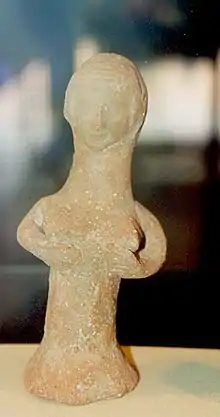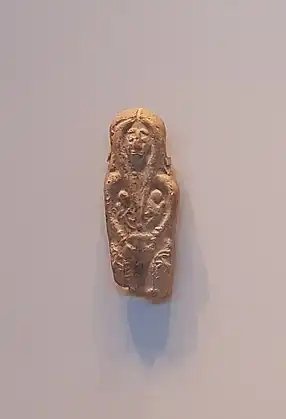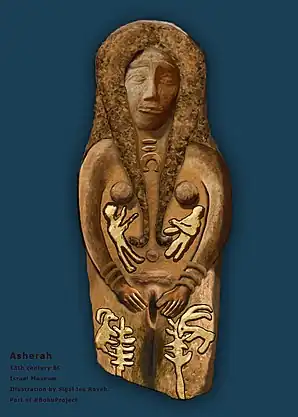The Revadim Asherah is a significant artifact representing a third genre of Asherah figurines.[2] Like the inscriptions found at Khirbet el-Qom and Kuntillet Ajrud, it's one of the most pivotal discoveries in the field from the latter half of the 20th century. These findings reoriented scholarship to the fact of Asherah's prominence in Canaanite and Hebrew religion.[3]

Depiction
The figure is the Great Mother, portrayed displaying her vulva and feeding twins.[4] Tadmor emphasizes that the figure represents a deity, not a wetnurse.[5] She has features such as long locks that are reminiscent of snakes directed towards the infants she cradles, jewelry adorning her wrists and neck, where hangs a large crescent pendant. Her hands open the yoni, and above is a ridge suggesting pubic hair. Engraved on each of her legs are depictions of tall trees accompanied by horned animals.[6] The trees are tall and sparse, and the caprids have curved horns like ibices.
The crowded symbolism of the Revadim Asherah stands in contrast to stark Judean pillar figurines. Whereas the pillar figures are plain, definitionally emphasizing their face and breasts without detail below, the Revadim prototype is maximalist, filling all possible space with sophisticated polysemy.
Specimens
Following publication in 1986, examples fleshing out the genus were found: Aphek, Tel Harasim, Tel Burna, and Revadim constitute all Revadim-type finds as of 2015. Differences are regional features, as they're dated mutual contemporaries of the latter 13th century.[7]
A Tel Burna goddess differed most in jewelry around the chest:
A horizontal line of three small pellets appears at the neck. Two braids depicting hair extend down the chest area, similar to the Egyptian Hathor style, are separated by an amorphous-shaped decoration just above the navel. There is a crescent or ring connected to a unique vertical band of eight rings extending down between these braids. This vertical row of rings running down the woman’s chest is unique. The crescent (or ring) shape near the woman’s neck is also distinctive.
The overall impression is of a long necklace of many small chained elements.[8]
Good sense and openmindedness are a boon when evaluating the figures, as depictions are often flatly "false or vague."[9]
External
- https://www.flickr.com/photos/pelegrino/13020564973 CC-licensed high-res photo by Nick Thompson. NB: the caption repeats incorrect information from
- https://www.imj.org.il/en/collections/198014-0 Israel Museum
See also
References
Notes
- ↑ Margalit 1989, pp. 371–378.
- ↑ Beck 1986, pp. 29–34.
- ↑ Sharp, McKinny & Shai 2015, pp. 61.
- ↑ Dever 2005, p. 188.
- ↑ תדמור & Tadmor 2011, pp. 419–424.
- ↑ Margalith 1994, pp. 109–115.
- ↑ Sharp, McKinny & Shai 2015, pp. 65.
- ↑ Strata: Bulletin of the Anglo-Israel Archaeolocial Society 2015 Volume Sharp, Casey. The Late Bronze Age Figurines from Tel Burna.
- ↑ Cornelius 2004.
Bibliography
NB: Margalit and Margalith are different scholars.
- Beck, Pirhiya (1986). "A new Type of Female Figurine". Insight through images: Studies in honor of Edith Porada: 29–34.
- תדמור, מרים; Tadmor, Miriam (2011). "The Figurine from Revadim—Wet-nurse or Child-bearing Woman? / הצלמית מרבדים — מינקת או יולדת?". Eretz-Israel: Archaeological, Historical and Geographical Studies / ארץ-ישראל: מחקרים בידיעת הארץ ועתיקותיה. Israel Exploration Society. ל: 419–424. ISSN 0071-108X. JSTOR 23630993. Retrieved 2023-10-18.
- Dever, William G. (2005). Did God Have a Wife?. Grand Rapids (Mich.): William B. Eerdmans Publishing Company. ISBN 0-8028-2852-3.
- Margalith, Othniel (1994). "A New Type of Asherah-Figurine?". Vetus Testamentum. Brill. 44 (1): 109–115. ISSN 0042-4935. JSTOR 1519430. Retrieved 2023-10-18.
- Via: Margalit, Baruch (1989). "Some Observations on the Inscription and Drawing from Khirbet el-Qôm". Vetus Testamentum. Brill. 39 (3): 371–378. ISSN 0042-4935. JSTOR 1519611. Retrieved 2023-10-19. O. Turfnell pl XLVIIB p 229 Pubic triangle is substituted for the stereotyped tree w flanking ibices: "the tree... symbolized the fertility goddess Asherah."
- Puech, Émile (2014). "Les inscriptions hébraïques de Kuntillet 'Ajrud (Sinaï)". Revue Biblique. 121 (2): 161–194. doi:10.2143/RBI.121.2.3157150. ISSN 2466-8583. JSTOR 44092490.
- Sharp, Casey; McKinny, Chris; Shai, Itzhaq (2015). "The Late Bronze Age Figurines from Tel Burna". STRATA Bulletin of the Anglo-Israel Archaeological Society. London: The Anglo-Israel Archaeological Society. 33: 61–79. There are "copious amounts of scholarship on their context and iconography." p. 71 Distrib. across economic classes p. 64
- Cornelius, Sakkie (2004). "A Preliminary Typology for the Female Plaque Figurines and Their Value for the Religion of Ancient Palestine and Jordan" (PDF). Journal of Northwest Semitic Languages 30/1. 30 (1): 21–39. Retrieved 2023-10-19. "One cannot always trust excavation reports or catalogues, nor photographs or secondary line-drawings."

